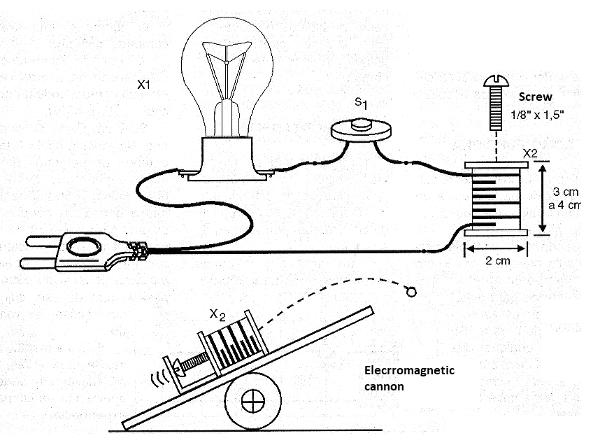At a science fair it serves to demonstrate important principles of electromagnetism and how practical assembly serves for some jokes and even practical applications. As a joke we can use it as a small "cannon" capable of launching projectiles at a good distance (which depends on the skill of the assembler and the characteristics of the components used.
HOW IT WORKS
We first recall that a solenoid is nothing more than a coil that has a moving core. When a current travels through this coil a strong magnetic field is created that pulls the nucleus to its interior if it is partially out. If we couple any device that is to be driven to this nucleus we will have the necessary force to do so.
In washing machines we find a solenoid that, when energized, pulls a through valve that lets the water flow. In our case the solenoid can either be taken advantage of some appliances of non-use appliances such as a washing machine as well as rolled up by the fitter himself with fine enameled wire.
To limit the current so that the solenoid does not present problems of short circuit or overheating, we connect in series a common lamp.
ASSEMBLY
In figure 1 we have the complete diagram of the solenoid demonstration apparatus.

In figure 2 we have the circuit aspect with details of the solenoid.

To mount the solenoid we can wind 500 to 2 000 turns of enameled wire in order to obtain a reasonable attraction force. The screw should slide through the small spool of cardboard used as a form for the spool.
This coil is coiled with fine enameled wire that can be used for buzzers, reactors or transformers out of use as long as they have no signs of burning, which is perceived by the strong smell when opening the piece. The core is a common long screw.
The incandescent lamp with voltage according to the power grid can have power from 25 to 40 watt. S1 is a push button. In the same figure 2 we have the way to make a small cannon that will throw Styrofoam balls or beans in the distance when the screw is pulled into the coil.
If the reader wishes, he may try to take advantage of the coil of a solenoid removed from an old-fashioned washing machine or the coil of a bell or other devices in which the core can be removed. Of course the coil should be tested first, because if it is shorted or open it will not fit the experience.
TEST AND USE
Remember that this circuit is connected directly to the power grid and that therefore you should avoid contact with any of its parts that can give dangerous shocks. Isolate all the stitches we have seen as wire splices and connection points. To try the solenoid place half of the screw inside the coil and press S1. The bulb should light up with reduced brightness and the screw should be drawn into the coil.
If the lamp does not light up and there is no power signal by pulling the screw, check the coil connections. The enameled wire should be scraped at the point of attachment.
Do not leave switch S1 pressed too long because the coil may overheat.
WHAT TO EXPLAIN
The reader should look for information about electromagnets and solenoids in the physics and electricity books and explain how these devices work. You should give examples of applications of these devices in common appliances such as washing machines and electronic locks.
Explain that the force of attraction depends on the intensity of the current and that the lamp limits this current. You can increase the intensity of the current if you change the lamp used by a higher power. It will be interesting to prepare a poster showing how the magnetic field strength lines created by the coil spread and how they focus on the core in order to pull it.
SUGGESTIONS
An electric lock or even a washing machine solenoid has a very large force and this can be demonstrated if the reader gets one in good condition. In these cases you will not need to use the lamp as a current limiter if they are specified to be connected directly to the power grid.
With thick wire you can make a smaller solenoid that would be powered by large common batteries. Of course, this solenoid would have a smaller force depending on how it was done. The advantage of a battery-powered solenoid is safety in the demonstration.
X1 - Lamp of 25 to 60 watt according to the local network
S1 – Push button
X2 - Solenoid - see text
Several:
Power cable, lamp socket, enameled wires, spool, solder, etc.



